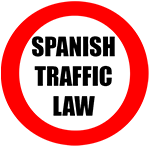1. If, due to incident or damage, the vehicle or its load obstructs the road, the drivers, after properly signalling the vehicle or the obstacle created, should take the necessary measures for it to be removed in the shortest possible time, they must remove it from the road and place it in compliance with parking regulations whenever feasible (article 51.2 of the articulated text).

The image shows how one of the drivers places the triangle to signal the incident. That distance is not enough, remember that the triangle must be at least 50 metres from the vehicle and be visible from 100 metres.
2. In any case of emergency, whenever a vehicle is immobilised on the road or its load has fallen on it, the driver or, as far as possible, the occupants of the vehicle will try to move the aforementioned somewhere which causes the least obstruction to traffic, for which they may use, where appropriate, the hard shoulder or median; likewise, they will adopt the appropriate measures so that the vehicle and cargo are removed from the road in the shortest possible time.
3. In the cases referred to in the previous section, without prejudice to turning on the emergency light if the vehicle bears it and, where appropriate, the position and clearance lights, while the road is left clear, all drivers must use the regulatory hazard warning devices to warn others of this circumstance, unless the traffic conditions do not allow it. Such devices should be placed, at least 50 metres away and in such a way that they are visible from at least 100 metres by the approaching drivers, one hazard warning in front and one behind the vehicle or cargo. On single-way roads, or more than three lanes, the installation of a single device, located at least 50 metres away to the rear, in the aforementioned manner, will suffice.
Although the law requires placing only one triangle when the direction of traffic flows in one direction, it is advisable to place the two at 100 and 50 metres respectively.

Do not forget that if the fault or incident occurs after a curve or change of gradient, you must place the triangle before the curve or hump, to warn drivers to take special care.

4. If it is necessary to ask for help, the nearest distress post should be used, if the road has one; otherwise, it may be requested from other road users. In any case and as long as it is possible, no one should cross the road.
5. The towing of an incident or damaged vehicle must only be carried out by another vehicle specifically designed for this purpose. Exceptionally, and always considering safety conditions, towing by other vehicles will be allowed, but only to the nearest place where it can be conveniently immobilised and as long as it doesn’t obstruct traffic. In no case will said exception be applicable on motorways or carriageways.

A-frames are not permitted in Spain, even if a foreign vehicle is visiting the country, they are not allowed.
Only breakdown trucks that have this sign at the front, are authorised to perform the rescue of vehicles on the roads.
The towing of a vehicle by the other is only allowed exceptionally and to the nearest place that is sufficiently safe to leave it there until assistance comes.

Remember that “A-frames” are not allowed in Spain, since as a general rule you cannot tow a vehicle, so you can only tow vehicles using approved trailers.
6. When the emergency occurs in a vehicle intended for the transport of dangerous goods, specific rules will also apply.






